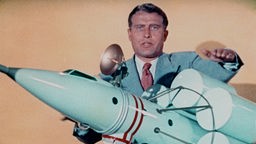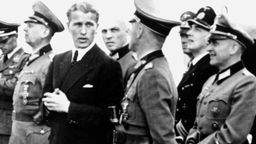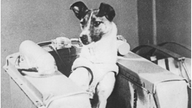Het volgende artikel komt van
OSNetDaily. Hierin de geschiedenis van Otto Skorzeny, een SS nazi moordenaar, die in de rang van luitenant-kolonel door Hitler werd beloond met het ridderkruis behorend tot het ijzeren kruis. Deze opperschoft trad na WOII in dienst van de Mossad, de Israëlische geheime dienst!!
Op deze plek heb ik al eens geschreven over de officieren uit het Israëlische leger, die begin 90er jaren naar buiten kwamen met het bericht, dat zij uit SS lesboeken werden onderwezen, bijvoorbeeld hoe een getto (zoals de Gazastrook nu is) te beheersen en controleren.......
Het is een lap tekst mensen, maar meer dan de moeite waard!!!
Declassified:
Iconic Nazi Commando Otto Skorzeny Became Mossad Hitman
Otto
Skorzeny, one of the Mossad’s most valuable assets, was a former
lieutenant colonel in Nazi Germany’s Waffen-SS and one of Adolf
Hitler’s favorites.
On
September 11, 1962, a German scientist vanished. The basic facts were
simple: Heinz Krug had been at his office, and he never came home.
The
only other salient detail known to police in Munich was that Krug
commuted to Cairo frequently. He was one of dozens of Nazi rocket
experts who had been hired by Egypt to develop advanced weapons for
that country.
HaBoker,
a now defunct Israeli newspaper, surprisingly claimed to have the
explanation: The Egyptians kidnapped Krug to prevent him from doing
business with Israel.
But
that somewhat clumsy leak was an attempt by Israel to divert
investigators from digging too deeply into the case — not that they
ever would have found the 49-year-old scientist.
We
can now report — based on interviews with former Mossad officers
and with Israelis who have access to the Mossad’s archived secrets
from half a century ago — that Krug was murdered as part of an
Israeli espionage plot to intimidate the German scientists working
for Egypt.
Moreover,
the most astounding revelation is the Mossad agent who fired the
fatal gunshots: Otto Skorzeny, one of the Israeli spy agency’s most
valuable assets, was a former lieutenant colonel in Nazi Germany’s
Waffen-SS and one of Adolf Hitler’s personal favorites among the
party’s commando leaders. The Führer, in fact, awarded Skorzeny
the army’s most prestigious medal, the Knight’s Cross of the Iron
Cross, for leading the rescue operation that plucked his friend
Benito Mussolini out from the hands of his captors.
But
that was then. By 1962, according to our sources — who spoke only
on the promise that they not be identified — Skorzeny had a
different employer. The story of how that came to be is one of the
most important untold tales in the archives of the Mossad, the agency
whose full name, translated from Hebrew, is “The Institute for
Intelligence and Special Missions.”
Key
to understanding the story is that the Mossad had made stopping
German scientists then working on Egypt’s rocket program one of its
top priorities. For several months before his death, in fact, Krug,
along with other Germans who were working in Egypt’s
rocket-building industry, had received threatening messages. When in
Germany, they got phone calls in the middle of the night, telling
them to quit the Egyptian program. When in Egypt, some were sent
letter bombs — and several people were injured by the explosions.
Krug,
as it happens, was near the top of the Mossad’s target list.
During
the war that ended 17 years earlier, Krug was part of a team of
superstars at Peenemünde, the military test range on the coast of
the Baltic Sea, where top German scientists toiled in the service of
Hitler and the Third Reich. The team, led by Wernher von Braun, was
proud to have engineered the rockets for the Blitz that nearly
defeated England. Its wider ambitions included missiles that could
fly a lot farther, with greater accuracy and more destructive power.
According
to Mossad research, a decade after the war ended, von Braun invited
Krug and other former colleagues to join him in America. Von Braun,
his war record practically expunged, was leading a missile
development program for the United States. He even became one of the
fathers of the NASA space exploration program. Krug opted for
another, seemingly more lucrative option: joining other scientists
from the Peenemünde group — led by the German professor Wolfgang
Pilz, whom he greatly admired — in Egypt. They would set up a
secret strategic missile program for that Arab country.
In
the Israelis’ view, Krug had to know that Israel, the country where
so many Holocaust survivors had found refuge, was the intended target
of his new masters’ military capabilities. A committed Nazi would
see this as an opportunity to continue the ghastly mission of
exterminating the Jewish people.
The
threatening notes and phone calls, however, were driving Krug crazy.
He and his colleagues knew that the threats were from Israelis. It
was obvious. In 1960, Israeli agents had kidnapped Adolf Eichmann,
one of the chief administrators of the Holocaust, in far-off
Argentina. The Israelis astonishingly smuggled the Nazi to Jerusalem,
where he was put on trial. Eichmann was hanged on May 31, 1962.
It
was reasonable for Krug to feel that a Mossad noose might be
tightening around his neck, too. That was why he summoned help: a
Nazi hero who was considered the best of the best in Hitler’s
heyday.
On
the day he vanished, according to our new information from reliable
sources, Krug left his office to meet Skorzeny, the man he felt would
be his savior.
Skorzeny,
then 54 years old, was quite simply a legend. A dashing, innovative
military man who grew up in Austria — famous for a long scar on the
left side of his face, the result of his overly exuberant swordplay
while fencing as a youth— he rose to the rank of lieutenant colonel
in Nazi Germany’s Waffen-SS. Thanks to Skorzeny’s exploits as a
guerrilla commander, Hitler recognized that he had a man who would go
above and beyond, and stop at nothing, to complete a mission.
The
colonel’s feats during the war inspired Germans and the grudging
respect of Germany’s enemies. American and British military
intelligence labeled Skorzeny “the most dangerous man in Europe.”
Krug
contacted Skorzeny in the hope that the great hero — then living in
Spain — could create a strategy to keep the scientists safe.
The
two men were in Krug’s white Mercedes, driving north out of Munich,
and Skorzeny said that as a first step he had arranged for three
bodyguards. He said they were in a car directly behind and would
accompany them to a safe place in a forest for a chat. Krug was
murdered, then and there, without so much as a formal indictment or
death sentence. The man who pulled the trigger was none other than
the famous Nazi war hero. Israel’s espionage agency had managed to
turn Otto Skorzeny into a secret agent for the Jewish state.
After
Krug was shot, the three Israelis poured acid on his body, waited
awhile and then buried what was left in a hole they had dug
beforehand. They covered the makeshift grave with lime, so that
search dogs — and wild animals — would never pick up the scent of
human remains.
The
troika that coordinated this extrajudicial execution was led by a
future prime minister of Israel, Yitzhak Shamir, who was then head of
the Mossad’s special operations unit. One of the others was Zvi
“Peter” Malkin, who had tackled Eichmann in Argentina and in
later life would enter the art world as a New York-based painter.
Supervising from a distance was Yosef “Joe” Raanan, who was the
secret agency’s senior officer in Germany. All three had lost large
numbers of family members among the 6 million Jews murdered by the
cruel, continent-wide genocide that Eichmann had managed.
Israel’s
motivation in working with a man such as Skorzeny was clear: to get
as close as possible to Nazis who were helping Egypt plot a new
Holocaust.
The
Mossad’s playbook for protecting Israel and the Jewish people has
no preordained rules or limits. The agency’s spies have evaded the
legal systems in a host of countries for the purpose of liquidating
Israel’s enemies: Palestinian terrorists, Iranian scientists, and
even a Canadian arms inventor named Gerald Bull, who worked for
Saddam Hussein until bullets ended his career in Brussels in 1990.
Mossad agents in Lillehammer, Norway, even killed a Moroccan waiter
in the mistaken belief that he was the mastermind behind the 1972
Munich Olympics massacre of 11 Israeli athletes by the terrorist
group known as Black September. Ahmed Bouchikhi was shot down in 1973
as he left a movie theatre with his pregnant wife. The Israeli
government later paid compensation to her without officially
admitting wrongdoing. The botched mission delayed further Mossad
assassinations, but it did not end them.
To
get to unexpected places on these improbable missions, the Mossad has
sometimes found itself working with unsavory partners. When
short-term alliances could help, the Israelis were willing to dance
with the proverbial devil, if that is what seemed necessary.
But
why did Skorzeny work with the Mossad?
He
was born in Vienna in June 1908, to a middle-class family proud of
its military service for the Austro-Hungarian Empire. From an early
age he seemed fearless, bold and talented at weaving false, complex
tales that deceived people in myriad ways. These were essential
requirements for a commando officer at war, and certainly valuable
qualities for the Mossad.
He
joined Austria’s branch of the Nazi Party in 1931, when he was 23,
served in its armed militia, the SA, and enthusiastically worshipped
Hitler. The führer was elected chancellor of Germany in 1933 and
then seized Austria in 1938. When Hitler invaded Poland in 1939 and
World War II broke out, Skorzeny left his construction firm and
volunteered — not for the regular army, the Wehrmacht, but for the
Leibstandarte SS Panzer division that served as Hitler’s personal
bodyguard force.
Skorzeny,
in a memoir written after the war was over, told of his years of SS
service as though they were almost bloodless travels in occupied
Poland, Holland and France. His activities could not have been as
innocuous as his book made them seem. He took part in battles in
Russia and Poland, and certainly the Israelis believed it was very
likely that he was involved in exterminating Jews. The Waffen-SS,
after all, was not the regular army; it was the military arm of the
Nazi Party and its genocidal plan.
His
most famous and daring mission was in September 1943: leading
commandos who flew engineless gliders to reach an Italian mountaintop
resort to rescue Hitler’s friend and ally, the recently ousted
Fascist dictator Benito Mussolini and spirit him away under harrowing
conditions.
This
was the escapade that earned Skorzeny his promotion to lieutenant
colonel — and operational control of Hitler’s SS Special Forces.
Hitler also rewarded him with several hours of face-to-face
conversation, along with the coveted Knight’s Cross. But it was far
from his only coup.
In
September 1944, when Hungary’s dictator, Admiral Miklos Horthy, a
Nazi ally, was on the verge of suing for peace with Russia as Axis
fortunes plunged, Skorzeny led a contingent of Special Forces into
Budapest to kidnap Horthy and replace his government with the more
hard-line Fascist Arrow Cross regime. That regime, in turn, went on
to kill or to deport to concentration camps tens of thousands of
Hungarian Jews who had managed to survive the war up to that point.
Also
in 1944, Skorzeny handpicked 150 soldiers, including some who spoke
fair to excellent English in a bold plan to fend off the Allies after
they landed in Normandy on D-Day in June. With the Allies advancing
through France, Skorzeny dressed his men in captured U.S. uniforms,
and procured captured American tanks for them to use in attacking and
confusing Allied troops from behind their own lines.
The
bold deception — including the act of stealing U.S. soldiers’
property — plunged Skorzeny into two years of interrogation,
imprisonment and trial after the war ended. Eventually, Allied
military judges acquitted him in 1947. Once again, the world’s
newspapers headlined him as Europe’s most dangerous man. He enjoyed
the fame, and published his memoirs in various editions and many
languages, including the 1957 book “Skorzeny’s Special Missions:
The Autobiography of Hitler’s Commando Ace,” published by
Greenhill Books. He spun some tall-tale hyperbole in the books, and
definitely downplayed his contacts with the most bloodthirsty Nazi
leaders. When telling of his many conversations with Hitler, he
described the dictator as a caring and attentive military strategist.
There
was much that Skorzeny did not reveal, including how he escaped from
the American military authorities who held him for a third year after
his acquittal. Prosecutors were considering more charges against him
in the Nuremberg tribunals, but during one transfer he was able to
escape — reputedly with the help of former SS soldiers wearing
American military police uniforms.
Skorzeny’s
escape was also rumored to have been assisted by the CIA’s
predecessor agency, the Office of Special Services, for which he did
some work after the war. It is certainly notable that he was allowed
to settle in Spain — a paradise for Nazi war veterans, with
protection from the pro-Western Fascist, Generalissimo Francisco
Franco. In the years that followed he did some advisory work for
President Juan Peron in Argentina and for Egypt’s government. It
was during this period that Skorzeny became friendly with the
Egyptian officers who were running the missile program and employing
German experts.
In
Israel, a Mossad planning team started to work on where it could be
best to find and kill Skorzeny. But the head of the agency, Isser
Harel, had a bolder plan: Instead of killing him, snare him.
Mossad
officials had known for some time that to target the German
scientists, they needed an inside man in the target group. In effect,
the Mossad needed a Nazi.
The
Israelis would never find a Nazi they could trust, but they saw a
Nazi they could count on: someone thorough and determined, with a
record of success in executing innovative plans, and skilled at
keeping secrets. The seemingly bizarre decision to recruit Skorzeny
came with some personal pain, because the task was entrusted to
Raanan, who was also born in Vienna and had barely escaped the
Holocaust. As an Austrian Jew, his name was originally Kurt Weisman.
After the Nazis took over in 1938, he was sent — at age 16 — to
British-ruled Palestine. His mother and younger brother stayed in
Europe and perished.
Like
many Jews in Palestine, Kurt Weisman joined the British military
looking for a chance to strike back at Germany. He served in the
Royal Air Force. After the creation of Israel in 1948, he followed
the trend of taking on a Hebrew name, and as Joe Raanan he was among
the first pilots in the new nation’s tiny air force. The young man
rapidly became an airbase commander and later the air force’s
intelligence chief.
Raanan’s
unique résumé, including some work he did for the RAF in
psychological warfare, attracted the attention of Harel, who signed
him up for the Mossad in 1957. A few years later, Raanan was sent to
Germany to direct the secret agency’s operations there — with a
special focus on the German scientists in Egypt. Thus it was Raanan
who had to devise and command an operation to establish contact with
Skorzeny, the famous Nazi commando.
The
Israeli spy found it difficult to get over his reluctance, but when
ordered, he assembled a team that traveled to Spain for “pre-action
intelligence.” Its members observed Skorzeny, his home, his
workplace and his daily routines. The team included a German woman in
her late 20s who was not a trained, full-time Mossad agent but a
“helper.” Known by the Hebrew label “saayanit” (or “saayan”
if a male), this team member was like an extra in a grandly
theatrical movie, playing whatever role might be required. A saayanit
would often pose as the girlfriend of an undercover Mossad combatant.
Internal
Mossad reports later gave her name as Anke and described her as
pretty, vivacious and truly flirtatious. That would be perfect for
the job at hand — a couples game.
One
evening in the early months of 1962, the affluent and ruggedly
handsome — though scarred — Skorzeny was in a luxurious bar in
Madrid with his significantly younger wife, Ilse von Finckenstein.
Her own Nazi credentials were impeccable; she was the niece
of Hjalmar
Schacht, Hitler’s talented finance minister.
They
had a few cocktails and were relaxing, when the bartender introduced
them to a German-speaking couple he had been serving. The woman was
pretty and in her late 20s, and her escort was a well-dressed man of
around 40. They were German tourists, they said, but they also told a
distressing story: that they had just survived a harrowing street
robbery.
They
spoke perfect German, of course, the man with a bit of an Austrian
accent, like Skorzeny’s. They gave their false names, but in
reality they were, respectively, a Mossad agent whose name must still
be kept secret and his “helper,” Anke.
There
were more drinks, then somewhat flamboyant flirting, and soon
Skorzeny’s wife invited the young couple, who had lost everything —
money, passports and luggage — to stay the night at their sumptuous
villa. There was just something irresistible about the newcomers. A
sense of sexual intimacy between the two couples was in the air.
After the four entered the house, however, at a crucial moment when
the playful flirting reached the point where it seemed time to pair
off, Skorzeny — the charming host — pulled a gun on the young
couple and declared: “I know who you are, and I know why you’re
here. You are Mossad, and you’ve come to kill me.”
The
young couple did not even flinch. The man said: “You are
half-right. We are from Mossad, but if we had come to kill you, you
would have been dead weeks ago.”
“Or
maybe,” Skorzeny said, “I would rather just kill you.”
Anke
spoke up. “If you kill us, the ones who come next won’t bother to
have a drink with you, You won’t even see their faces before they
blow out your brains. Our offer to you is just for you to help us.”
After
a long minute that felt like an hour, Skorzeny did not lower his gun,
but he asked: “What kind of help? You need something done?” The
Mossad officer — who even now is not being named by colleagues —
told Skorzeny that Israel needed information and would pay him
handsomely.
Hitler’s
favorite commando paused for a few moments to think, and then
surprised the Israeli by saying: “Money doesn’t interest me. I
have enough.”
The
Mossad man was further surprised to hear Skorzeny name something that
he did want: “I need for Wiesenthal to remove my name from his
list.” Simon Wiesenthal, the famous Vienna-based Nazi-hunter, had
Skorzeny listed as a war criminal, but now the accused was insisting
he had not committed any crimes.
The
Israeli did not believe any senior Nazi officer’s claim of
innocence, but recruiting an agent for an espionage mission calls for
well-timed lies and deception. “Okay,” he said, “that will be
done. We’ll take care of that.”
Skorzeny
finally lowered his weapon, and the two men shook hands. The Mossad
man concealed his disgust.
“I
knew that the whole story about you being robbed was bogus,”
Skorzeny said, with the boastful smile of a fellow intelligence
professional. “Just a cover story.”
The
next step to draw him in was to bring him to Israel. His Mossad
handler, Raanan, secretly arranged a flight to Tel Aviv, where
Skorzeny was introduced to Harel. The Nazi was questioned and also
received more specific instructions and guidelines. During this
visit, Skorzeny was taken to Yad Vashem, the museum in Jerusalem
dedicated to the memory of the 6 million Jewish victims of the
Holocaust. The Nazi was silent and seemed respectful. There was a
strange moment there when a war survivor pointed to Skorzeny and
singled him out by name as “a war criminal.”
Raanan,
as skilled an actor as any spy must be, smiled at the Jewish man and
softly said: “No, you’re mistaken. He’s a relative of mine and
himself is a Holocaust survivor.”
Naturally,
many in Israeli intelligence wondered if the famous soldier for
Germany had genuinely — and so easily — been recruited. Did he
really care so much about his image that he demanded to be removed
from a list of war criminals? Skorzeny indicated that being on the
list meant he was a target for assassination. By cooperating with the
Mossad, he was buying life insurance.
The
new agent seemed to prove his full reliability. As requested by the
Israelis, he flew to Egypt and compiled a detailed list of German
scientists and their addresses.
Skorzeny
also provided the names of many front companies in Europe that were
procuring and shipping components for Egypt’s military projects.
These included Heinz Krug’s company, Intra, in Munich.
Raanan
continued to be the project manager of the whole operation aimed
against the German scientists. But he assigned the task of staying in
contact with Skorzeny to two of his most effective operatives: Rafi
Eitan and Avraham Ahituv.
Eitan
was one of the most amazing characters in Israeli intelligence. He
earned the nickname “Mr. Kidnap” for his role in abducting
Eichmann and other men wanted by Israeli security agencies. Eitan
also helped Israel acquire materials for its secret nuclear program.
He would go on to earn infamy in the 1980s by running Jonathan
Pollard as an American Jewish spy in the United States government.
Surprisingly
flamboyant after a life in the shadows, in 2006, at age 79, Eitan
became a Member of Parliament as head of a political party
representing senior citizens.
“Yes,
I met and ran Skorzeny,” Eitan confirmed to us recently. Like other
Mossad veterans, he refused to go on the record with more details.
Ahituv,
who was born in Germany in 1930, was similarly involved in a wide
array of Israeli clandestine operations all around the globe. From
1974 to 1980 he was head of the domestic security service, Shin Bet,
which also guarded many secrets and often conducted joint projects
with the Mossad.
The
Mossad agents did try to persuade Wiesenthal to remove Skorzeny from
his list of war criminals, but the Nazi hunter refused. The Mossad,
with typical chutzpah, instead forged a letter — supposedly to
Skorzeny from Wiesenthal— declaring that his name had been cleared.
Skorzeny
continued to surprise the Israelis with his level of cooperation.
During a trip to Egypt, he even mailed exploding packages; one
Israeli-made bomb killed five Egyptians in the military rocket site
Factory 333, where German scientists worked.
The
campaign of intimidation was largely successful, with most of the
Germans leaving Egypt. Israel stopped the violence and threats,
however, when one team was arrested in Switzerland while putting
verbal pressure on a scientist’s family. A Mossad man and an
Austrian scientist who was working for Israel were put on trial.
Luckily, the Swiss judge sympathized with Israel’s fear of Egypt’s
rocket program. The two men were convicted of making threats, but
they were immediately set free.
Prime
Minister David Ben-Gurion, however, concluded that all of this being
out in public was disastrous to Israel’s image — and specifically
could upset a deal he had arranged with West Germany to sell weapons
to Israel.
Harel
submitted a letter of resignation, and to his shock, Ben-Gurion
accepted it. The new Mossad director, commander of military
intelligence Gen. Meir Amit, moved the agency away from chasing or
intimidating Nazis.
Amit
did activate Skorzeny at least once more, however. The spymaster
wanted to explore the possibility of secret peace negotiations, so he
asked Israel’s on-the-payroll Nazi to arrange a meeting with a
senior Egyptian official. Nothing ever came of it.
Skorzeny
never explained his precise reasons for helping Israel. His
autobiography does not contain the word “Israel,” or even “Jew.”
It is true that he sought and got the life insurance. The Mossad did
not assassinate him.
He
also had a very strong streak of adventurism, and the notion of doing
secret work with fascinating spies — even if they were Jewish —
must have been a magnet for the man whose innovative escapades had
earned him the Iron Cross medal from Hitler. Skorzeny was the kind of
man who would feel most youthful and alive through killing and fear.
It
is possible that regret and atonement also played a role. The
Mossad’s psychological analysts doubted it, but Skorzeny may have
genuinely felt sorry for his actions during World War II.
He
may have been motivated by a combination of all these factors, and
perhaps even others. But Otto Skorzeny took this secret to his grave.
He died of cancer, at age 67, in Madrid in July 1975.
He
had two funerals, one in a chapel in Spain’s capital and the other
to bury his cremated remains in the Skorzeny family plot in Vienna.
Both services were attended by dozens of German military veterans and
wives, who did not hesitate to give the one-armed Nazi salute and
sing some of Hitler’s favorite songs. Fourteen of Skorzeny’s
medals, many featuring a boldly black swastika, were prominently
paraded in the funeral processions.
There
was one man at the service in Madrid who was known to no one in the
crowd, but out of habit he still made sure to hide his face as much
as he could. That was Joe Raanan, who by then had become a successful
businessman in Israel.
The
Mossad did not send Raanan to Skorzeny’s funeral; he decided to
attend on his own, and at his own expense. This was a personal
tribute from one Austrian-born warrior to another, and from an old
spy handler to the best, but most loathsome, agent he ever ran.
Voor meer berichten n.a.v. het voorgaande, klik op één van de labels, die u onder dit bericht terug kan vinden, dit geldt niet vor de labels: Amit, Ben-Gurion, Ranaan, Skorzeny, von Braun en W. Pilz. Het aantal labels is veel te weinig, helaas kan ik daar niets aan veranderen (maximaal 200 tekens, of 20 labels).







